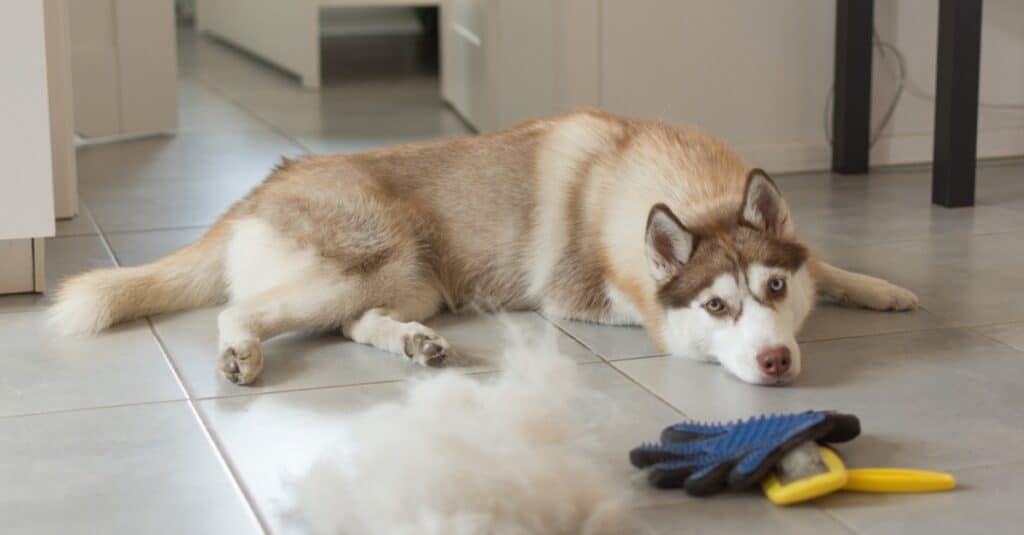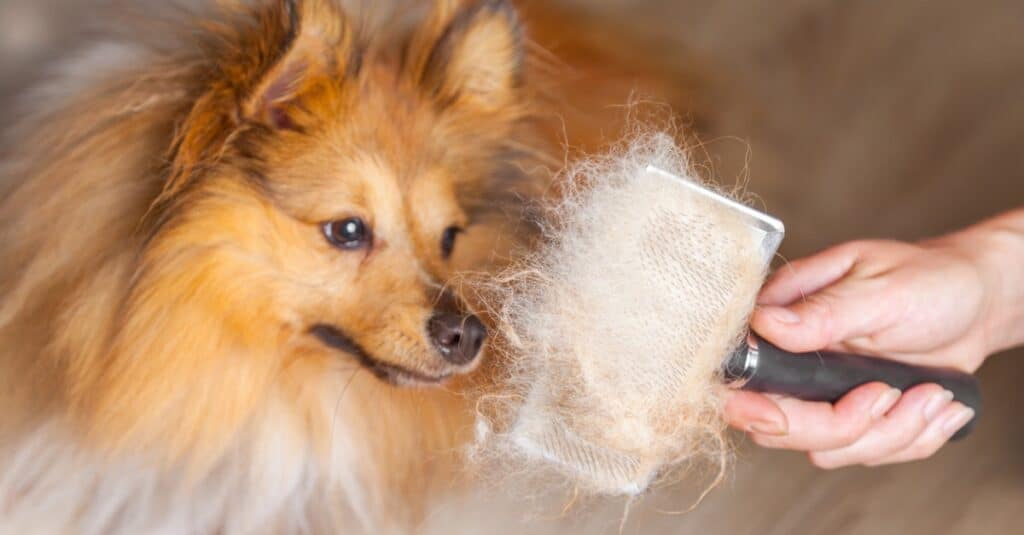Dogs with soft, fluffy coats of fur are snuggly and adorable. However, as any dog owner can attest, that furriness comes with drawbacks. After all, who enjoys constantly picking dog hair off their clothes or having to clean dog hair off the sofa when company visits?
One of the few practically universal complaints about dogs is how much they shed. Unfortunately, shedding is universal across all canines – even those marketed as “non-shedding” or “hypo-allergenic” – so it’s something that all dog owners must be prepared to manage.
So, why do dogs shed-and what can you do about it?
Understanding Dog Hair and How it Grows

©iStock.com/Inna Dodor
Fur is one of many things that makes dogs so adorable. However, its purpose extends far beyond aesthetics. Fur helps dogs control their body temperature, allowing them to stay warmer in the winter and cooler in the summer. Their coats also shield them from the sun and other potentially harmful environmental factors. In the winter, for instance, a good coat of fur can keep moisture at bay.
However, with time it becomes necessary for a new coat to grow. Dogs shed to get rid of their old worn and damaged coat and grow a new covering of fur.
To get to the bottom of why dogs shed, it helps to understand how their hair grows. Dogs typically have three types of hair:
- Primary Hair: Also known as the outer coat. Primary hair is longer and coarser than the underlying layer on most dogs. It generally grows slower than the hair below.
- Secondary Hair: Also known as the undercoat. Secondary hair is located beneath primary hair. It tends to be softer. It also usually grows faster than the primary hair. In most breeds, it molts off two times per year.
- Tactile Hair: Tactile hair is hair that dogs use to glean more information about their environments. Whiskers are the best example of tactile hair, as they allow dogs to feel their way through tight spaces more efficiently.
All animals have hair shafts that undergo phases of growth and shedding. These phases are affected by the growth rate of particular hair shafts, and this rate varies depending on factors like breed, hormones, health, environment, and age.
Some dog breeds have hair shafts with long lifespans. The resulting hair grows continuously but slowly, causing such breeds to shed very little compared to others. You’ll notice this phenomenon with breeds like Yorkshire Terriers and Poodles.
Other dog breeds’ hair shafts have much shorter lifespans, causing them to have thicker undercoats and, by extension, to molt hair more frequently. Breeds like Huskies and Labs are known to shed a lot more than many other types of dogs.
How Much Shedding is Normal for a Dog?
Since dogs vary so much by breed and other factors, there’s no such thing as a “normal” amount of shedding. Shedding occurs so that damaged, dead fur is eliminated to create room for strong, new, healthy fur to grow, and it is universal across all breeds.
The frequency at which dogs shed their fur varies depending on numerous factors, including breed, general physical health, pregnancy status, environment, and season. There’s no correct answer, therefore, for how often any particular dog may shed its fur. Once you get to know a dog, it’s easier to detect if they are shedding more than usual, which can indicate underlying health problems.
When Do Dogs Shed Their Fur?
All dogs undergo a normal shedding cycle. However, not all breeds shed heavily consistently. Some breeds constantly shed throughout the year regardless of the weather, and others tend to molt hair more often on a seasonal basis. For example, some breeds shed a lot of hair during the spring and fall in preparation for changing temperatures.
Top Factors Affecting How Much a Dog Sheds Its Fur
Some of the top factors affecting how often and how much a dog sheds its fur include the following:
- Breed: Some breeds of dogs are more prolific shedders than others. Heavy-shedding breeds include Beagles, Border Collies, German Shepherds, Akitas, Saint Bernards, Golden Retrievers and Alaskan Malamutes. Low-shedding breeds include Miniature Poodles, Maltese, Airedale Terriers and Irish Terriers.
- Seasonal Shedding: Most dogs shed, or molt, more in the spring and fall because of seasonal temperature changes. Sometimes referred to as “blowing coat,” this involves shedding the heavy winter undercoat during the spring and shedding the lighter undercoat during the fall. Outdoor dogs are more subject to seasonal variations than indoor pooches, who are less affected by changes in sunlight and temperature in the winter and summer.
- Stress: Stress-induced shedding is a common phenomenon experienced by most dogs at certain times in their lives. A major change in environment – say, moving to a new home – can trigger excessive shedding. Going to the veterinarian’s office can cause a dog to shed more prolifically due to stress. Sometimes, anxiety and other underlying issues can trigger more shedding than usual. Veterinarians can prescribe anti-anxiety medications and other treatments to address such issues.
- Skin Issues: Sometimes dogs start shedding more than usual because of underlying skin problems. In such instances, you may notice areas of sparse hair – or even bald spots – caused by parasites like mites, lice and fleas. Conditions like dermatitis, ringworm, and various fungal infections can also trigger excessive hair loss in canines. Underlying immune disorders and illnesses like cancer can also affect the skin, causing hair to molt more heavily and frequently.
- Allergies: Allergic reactions are sometimes responsible for excessive molting in dogs. These reactions can be triggered by many things, including certain foods, grooming supplies, medications or household cleaners. If your dog is shedding more than usual, a veterinarian can help pinpoint and treat underlying allergens at work.
Other Factors That May Affect Shedding in Dogs
In addition to the factors highlighted above, a few other phenomena can cause excessive shedding in particular dogs. One of these is pregnancy. While pregnant, a dog is more likely to suffer from nutritional deficiencies that trigger excessive hair loss. Low calcium levels are a common culprit, but pregnant dogs can also be deficient in other crucial nutrients.
Contrary to what many people think, puppies can and do shed. Most breeds are born with costs that are soft, delicate, and fluffy. Most puppies shed their newborn coats around the age of four to six months, and their thicker adult coats start coming in. The adult coat can take a while to develop in some breeds fully; for example, it can take up to two years for Pomeranians.
Tips for Managing Shedding in Dogs

©Filmbildfabrik/Shutterstock.com
Shedding and dogs go hand in hand. Most dog lovers are more than willing to take this small amount of “bad” with so much good. There are also lots of ways to keep shedding to a minimum. Keep these tips in mind to minimize shedding in your dog:
- Don’t Shave Its Fur Off: Although shaving a dog’s fur may seem a logical way to keep shedding at bay, it’s one of the worst things you can do to a pup. Shaving off a dog’s fur interferes with its natural self-warming and self-cooling mechanisms, making it harder for them to stay comfortable.
- Groom Your Dog Regularly: Having your dog properly groomed on a regular basis is one of the best ways to keep shedding to a minimum. Use a good oatmeal shampoo for dogs, or whatever type your groomer recommends for your breed, to keep their fur strong, shiny, healthy – and less likely to fall out constantly.
- Brush Your Dog Often with the Right Tools: Consult with a professional groomer or veterinarian for advice on which types of brushes to use on your canine friend. Make a point of brushing your dog regularly to minimize how much fur they shed. As a general rule, bristle brushes are ideal for dogs with coarse fur, and pin brushes are best for dogs with long, silky hair.
- Feed Your Dog a Healthy Diet: Since underlying nutritional deficiencies can wreak havoc on a dog’s skin and hair, it pays to help them maintain a healthy diet chock full of essential nutrients. Fatty acids, including omega-3 and omega-6 acids, are beneficial for maintaining healthy skin and hair. Many supplements and foods include these fatty acids along with things like vitamin E and zinc. Coconut oil, which contains healthy fats known as mid-chain triglycerides, or MCTs, is also helpful in this regard. You can add small amounts to your dog’s food for healthier skin and fur.
- Control Fleas and Allergies: As noted previously, excessive shedding may occur due to various allergic reactions. Fortunately, a veterinarian should be able to pinpoint the problem and provide appropriate treatment. Excessive scratching from fleas and other pests can trigger excessive molting, so make sure to provide your dog with a quality tick and flea treatment to keep such issues at bay.
- Avoid Gimmicky Treatments: Finally, although solutions like dog-shedding suits sound promising, most pups detest them and are miserable wearing them. Therefore, as tempting as it may be to invest in one, it’s generally best to stick with the techniques and options outlined above – and to accept that shedding is a fact of life for dogs.
Up Next…
Keep reading these posts for more incredible information about key animal facts.
- 9 Reasons Why Dogs Put Their Ears Back & What They’re Saying: There are many reasons why your pet canine folds its ears backwards. We’ve provided them here so you can understand your pet better.
- What Were Boxers Bred For? Original Use, Jobs, and History: They’re loyal, affectionate, and gentle. But such a temperament is at odds with the purpose for which they were originally bred. Discover the history of the Boxer right here.
- What Were Corgis Bred For? Original History, Jobs and Role: Clever and great family pets, they were popularised by the British royal family. Find out the true origins of these short legged, much loved canines.
The photo featured at the top of this post is © smrm1977/Shutterstock.com
Ready to discover the top 10 cutest dog breeds in the entire world?
How about the fastest dogs, the largest dogs and those that are -- quite frankly -- just the kindest dogs on the planet? Each day, AZ Animals sends out lists just like this to our thousands of email subscribers. And the best part? It's FREE. Join today by entering your email below.
Thank you for reading! Have some feedback for us? Contact the AZ Animals editorial team.






